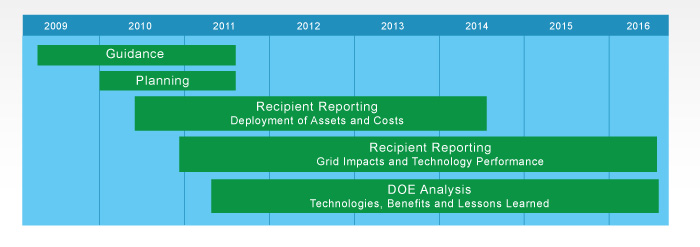The American Recovery and Reinvestment Act of 2009 (Recovery Act) provided the U.S. Department of Energy with $4.5 billion to modernize the electric power grid and to implement Title XIII of the Energy Independence and Security Act of 2007. This section provides descriptions and background information for each of the smart grid programs funded by the Recovery Act.
The two largest initiatives are the Smart Grid Investment Grant (SGIG) program and the Smart Grid Demonstration Program (SGDP), which were originally authorized by EISA, and later modified by the Recovery Act. DOE’s Office of Electricity Delivery and Energy Reliability (OE) is responsible for managing these five-year programs. SGIG focuses on deploying existing smart grid technologies, tools, and techniques to improve grid performance today. SGDP explores advanced smart grid and energy storage systems and evaluates performance for future applications.

The Recovery Act also provides $100 million for workforce training. The Workforce Training for the Electric Power Sector program involves colleges, universities, and electric power companies in developing curricula and materials for training engineers, technicians, and technical specialists with the skill sets needed to design, operate, and maintain the technologies and business systems (hardware and software) that comprise the Smart Grid.
One of the big unknowns in the development of the Smart Grid is the response of consumers. Projected benefits may fall short if consumers fail to participate in programs enabled by smart grid technologies such as those involving advanced metering, time-based rates, programmable communicating thermostats, Web portals and other demand response offerings. To address this uncertainty, a subset of SGIG projects are conducting statistically rigorous consumer behavior studies according to guidelines developed by DOE for assessing impacts on a variety of variables including peak demand, total electricity use, and consumer acceptance and retention.
A top priority of the SGIG and SGDP programs involves ensuring that projects properly address interoperability and cybersecurity. Interoperability is the capability of two or more networks, systems, devices, applications, or components to share and readily use information securely and effectively with little or no inconvenience to the user. Cybersecurity is the ability of electric networks to detect and respond to unwanted intrusions by hackers or terrorists into grid-connected software and hardware systems, including protections to prevent unauthorized access to data or system controls. DOE activities include development of standards and analysis tools, and assessment of lessons learned and best practices.

Learn more about these Recovery Act Smart Grid programs, studies and activities:
Projects
The location, information, and data for each smart grid project are provided in this section.Click for Projects
Publications
These reports include analysis, impacts, lessons learned, best practices, analytical tools, and case studies that were supported by the Recovery Act Smart Grid Programs.Click for Publications

